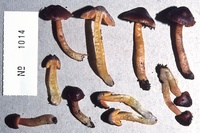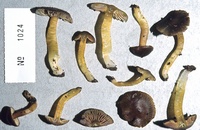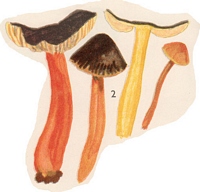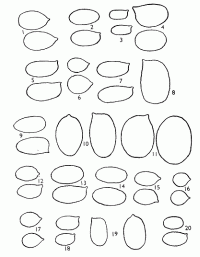|
 Hygrocybe fuscoaurantiaca Hygrocybe fuscoaurantiaca
SynonymsHygrophorus fuscoaurantiacus
BiostatusPresent in region - Indigenous. Endemic
Images (click to enlarge)
Caption: Fig. 15 Hygrocybe fuscoaurantiaca (Stev.) Horak (X-Z: ZT 1014):
X. basidiomes. Y. spores. Z. basidia. | 
Caption: ZT1014
Owner: E. Horak: © Creative Commons Attribution-Noncommercial 3.0 New Zealand | 
Caption: ZT1024
Owner: E. Horak: © Creative Commons Attribution-Noncommercial 3.0 New Zealand |  | 
Caption: Spores X 2000 1. Hygrophorus salmonipes 2; H. elsae; 3, H .julietae; 4, H. variabilis; 5, H. lilaceo-lamelllatus; 6, H. muritaiensis; 7, H. keithgeorgei; 8, H. pseudococcineus; 9, H. rubro-carnosus; 10, H. miniceps; 11, H. procerus; 12, H. multic |
Article: Stevenson, G. (1963) [1962]. The Agaricales of New Zealand: IV. Kew Bulletin 16(3): 373–384.
Description: Pileus 2-4.5 cm. diam., blackish brown, paler with orange or green tints at
first, matt, becoming covered in age with radiating fibrils; flesh yellow with
a brown layer immediately under the pellicle. Gills free to adnexed, deep, rather
distant, rather thick, pinkish orange with yellow margins. Stipe 4-6 X 0.5-1
cm., orange to scarlet, hollow, sometimes grooved and split. Spores 10-11 X
5-6 µm., oblong, hyaline, thin-walled. Basidia 40-45 X 6-9 µm., four-spored.
Habitat: habitat; in litter under forest, Keith George Park, Wellington,
30.5.1949 & 15.6.1949; Levin, 22.6.1958; all Stevenson.
Article: Horak, E. (1990). Monograph of the New Zealand Hygrophoraceae (Agaricales). New Zealand Journal of Botany 28(3): 255-306 (http://www.rsnz.org/publish/abstracts.php).
Description: Pileus -45 mm, hemispherical or conical becoming convex to expanded with low
umbo; dark red-brown or black-brown, fading to olive green, paler towards margin;
viscid, glabrous to minutely fibrillose or radially wrinkled, hygrophanous,
striate. - Lamellae 14-20 (1-3) adnexed to emarginate-adnate, ventricose, up
to 4 mm wide; red-brown to orange brown, paler or yellowish towards edges, occasionally
with green tint, edges entire, obtuse. - Stipe 25- 60 x 35 (-10) mm, cylindrical,
subfusoid to attenuate] towards base, rarely equal; yellow to orange (with red
tint), grey-green to whitish near base; subviscid (in wet condition), dry becoming
glabrous, hollow, brittle, single to caespitose. - Context dark brown to dark
olive beneath cuticle of pileus, orange-yellow- in upper portion of stipe, pale
green to whitish in base of stipe. - Odour and taste not distinctive. - Chemical
reactions on pileus: KOH - negative.
Spores 6-9 x 3.5-5.5 um, ellipsoid, constricted in dorso-ventral view. - Basidia
30-50 x 6- 9 um, 4-spored. - Cystidia absent - Pileipellis an ixocutis of cylindrical,
slightly gelatinised hyphae (3-8 um diam.), with reddish-brown (KOH) plasmatic
pigment; clamp connections present (Pl. 1, Fig. 7). .
Habitat: ECOLOGY: Scattered; saprobic on soil among litter of Beilschmiedia, Leptospermum
scoparium, and Kunzea ericoides or in broadleaved-conifer forests
with tree ferns. May-July.
Distribution: DISTRIBUTION: NZ (NA, W).
Article: Horak, E. (1971). A contribution towards the revision of the Agaricales (Fungi) from New Zealand. New Zealand Journal of Botany 9(3): 403-462 (http://www.rsnz.org/publish/abstracts.php).
Notes: Hygrophorus fuscoaurantiacus Stevenson (28 D) = Hygrocybe fuscoaurantiaca
(Stevenson) comb. nov. (Basionym: H. fuscoaurantiacus Stevenson, Kew Bull.
16: 381, 1962.)
|